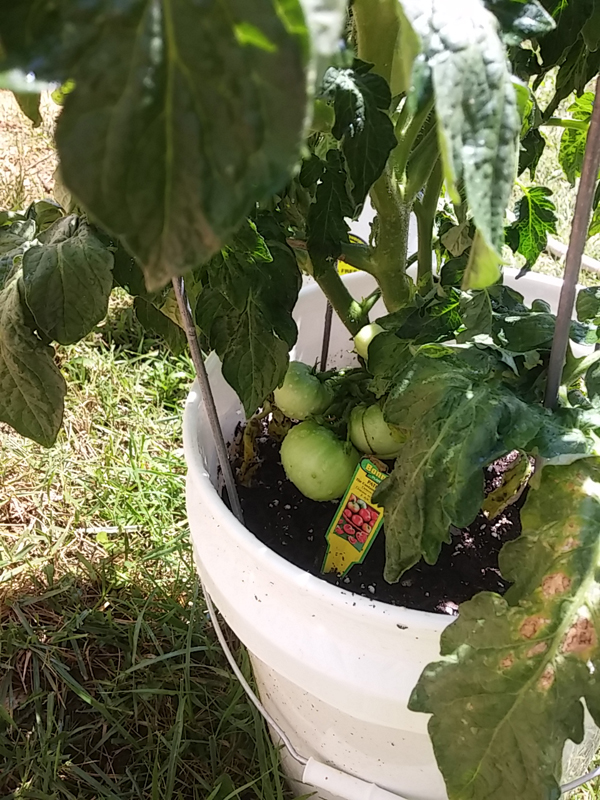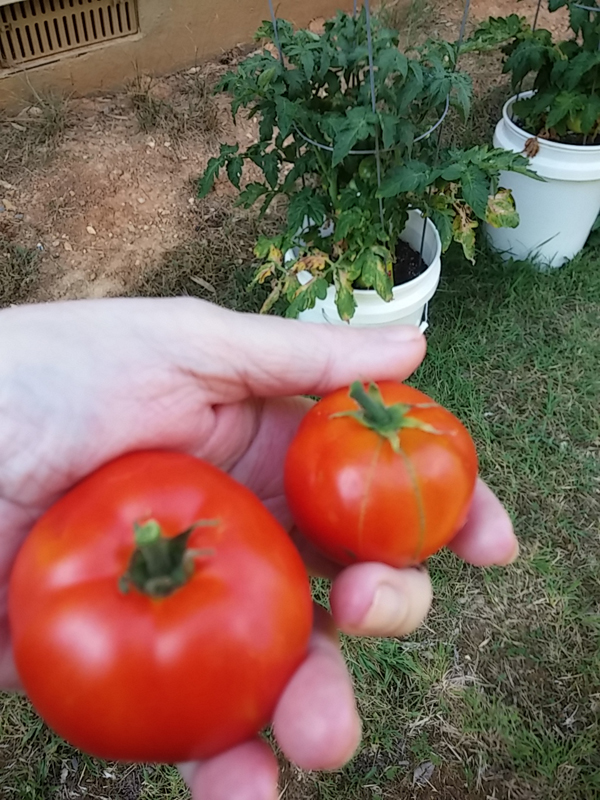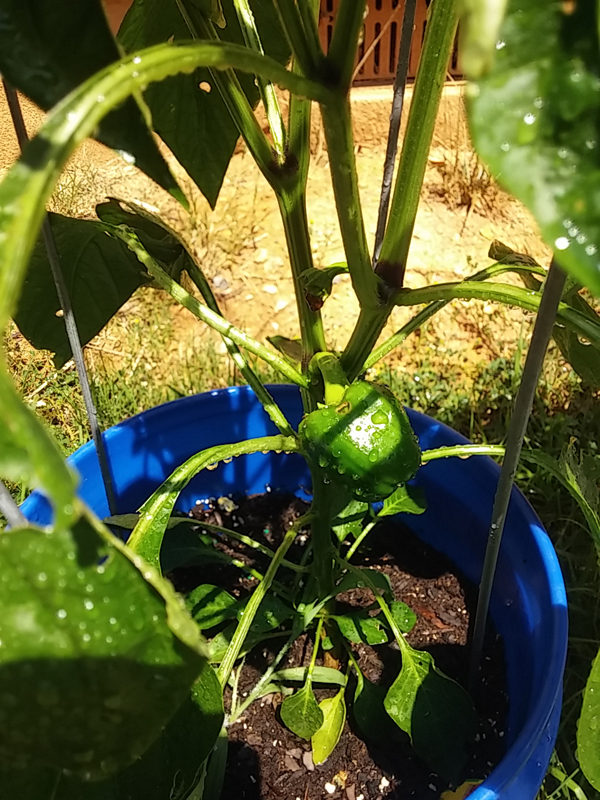I was so happy with my bucket garden last year that I am doing it again this year. I started this one last week on Mother’s Day, May 8, 2016, which is a few weeks earlier than last year. We’ve had a few cold nights this past week, so I hope they will be okay. They look good, so far.
To start, I used the four buckets from last year, plus three more. I had such good luck with the Bonnie patio tomatoes, so I bought two this time. My Bonnie Big Bertha Bell sweet peppers didn’t do so well last year, so this time I am trying two buckets of Bonnie Red Bell sweet peppers. I can never find starter green bean plants, so I have a few buckets with green bean seeds. Plus, I added one bucket of sunflower seeds. I also have some smaller pots with starter herbs; garlic basil, chives, curly parsley, and lemon thyme.
Planting my second five-gallon bucket garden – Sunday, May 8, 2016
This year, Lowes has white Food Grade five-gallon buckets that are great for planting vegetables. I honestly don’t know if it matters, but I will eventually change out all of my blue buckets for the white ones.
I had such great luck with the Bonnie patio tomatoes last year, so I bought two this year. The Cherokee Heirloom tomatoes didn’t do so well. My Big Bertha Bells didn’t produce much, only a few good red peppers by the time the season was over. So, this year, I’m trying the Bonnie Red Bell sweet peppers. I also planted quite a few pots of green bean seeds. I hope they do as well as they did last year.
Do birds eat tomatoes?
You bet they do! They just love those juicy, ripe tomatoes. I learned my lesson last year when I would go to pick my beautifully ripened tomatoes, only to find that the birds had been pecking at them. So, I searched for tomato plant netting and found the bird block netting at Amazon.com. It worked like a charm!
This time, I am prepared to guard against the hungry critters. I have the bird netting ready for when my plants start to bear fruit. It will definitely keep birds from eating tomatoes.
Easy Gardener 604 BirdBlock Netting
By June 12, 2016 I already noticed clusters of tomatoes and one green pepper, and on June 24, 2016, I picked my first two patio tomatoes.
 |
 |
 |
Check out my post, My First Five-Gallon Bucket Garden, where I go into more detail about prepping my pots and plants.
I decided to plant an herb garden this year. I started with four herbs that I commonly use in my recipes – basil, chives, parsley, and thyme.
Pest Control:
Neem Oil:
Neem Oil is great for repelling insects. Apparently, it affects their mental capacity and will sit there confused until a predator comes along, or they simply fall off the plant and die.
Dr. Bronner’s Organic Sal Suds mixed with neem oil allows it to stick to the plants.
Ingredients:
- 2 Tbsp of Neem Oil and 2 Tbsp of Dr. Bronner’s Organic Sal Suds per gallon of water.
*Note: I purchased the Chapin 20000 1-Gallon Poly Lawn and Garden Sprayer, Dyna-Gro Pure Neem Oil Natural Leaf Polish,, and Dr. Bonner’s Organic Sal Suds on Amazon. I’m sure you can find them at any garden center, Walmart, Lowes, Home Depot, etc.
Directions:
- In a small jar, mix Neem oil and Dr. Bonner’s Sal Suds with a cup of warm water. Shake or mix thoroughly.
- Pour into a sprayer. Fill with water to the 1-gallon mark. Mix well.
- Set the sprayer on fine mist. Spray early in the morning or evening, and not during full sun or it can burn your plants. I prefer early evening just as the sun sets. In the morning, it washes off with the first watering.
- I spray my plants with neem oil spray once or twice a week.
Diatomacious Earth:
Diatomaceous Earth is a powder made from fossilized prehistoric crustaceans called diatoms. The sharp edges of D-Earth cuts into the insects’ bodies, causing them to die naturally of dehydration. I know this sounds cruel, but it’s one of the best non-toxic solutions to keeping those pesky critters from destroying our plants.
D-Earth is less effective when wet, but can still be used in the garden on Japanese beetles or cutworms. In dry weather, sprinkle D-Earth on the soil where slugs, Japanese beetles, or other pests will come in contact with the soil. Reapply after rain or heavy dew.
Be sure to buy the food grade. I purchased my Diatomaceous Earth on Amazon, but I’m sure you can find it in most garden centers, such as Walmart, Lowes, Home Depot, etc.
When using indoors, wear a mask. It is best to use a pest control duster in order to get into small crevices.
I purchased Diatomaceous Earth on Amazon, but I’m sure you could find it at most garden centers, such as Walmart, Home Depot, Lowes, etc.
Can Diatomacious Earth hurt honeybees?
I have read conflicting opinions about the effect d-earth has on bees. The furry hairs on the bees help protect it, but thicker layers of d-earth can harm them. Now that I know it could be harmful, I have decided to use it with caution, and only for serious infestations. After application, it would be best to cover plants with a sheet so the bees can’t get to the plants. Then, uncover the plants and wash the D-Earth off with a fine spray of water.

